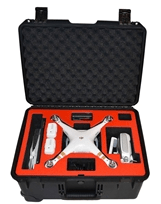 This article has been entirely updated to reflect current regulations as of March 2017.
This article has been entirely updated to reflect current regulations as of March 2017.
Traveling with a drone even in the US isn’t always easy. While there is no particular law about crossing state lines with a drones, airports are often touchy about things they don’t fully understand… things like LiPO batteries, and drones that fit into the overhead bin. Anytime you are carrying a piece of valuable equipment, whether for your job or your vacation, extra care is required – check out this article on How to Travel With Your Drone for some basic rules to follow.
When you are traveling internationally, some extra care may be required. Keep heart – many international flyers are traveling all over without a problem and meeting other members of the drone community while doing it! However, doing some research up front and remembering these simple points may make your travel experience go more smoothly.
#1. Your Part 107 license isn’t automatically legal in other countries. Got your Part 107 here in the states? If you are planning on flying commercially, you should know that your license is only good in the US. While there are international training standard for manned aircraft pilots, and reciprocal agreements with member countries, those agreements do not cover unmanned aircraft. You’ll have to check with your client or the country you’re working in to make sure that you are flying legally; the FAA has no authority in other countries.
#2. Some countries require that drones be declared. You’ll need to do your research before traveling – hit the government websites, and do a search on drone regulations. Despite increased commercial use of drones in India, for example, the government modified its customs baggage claim regulations last spring to require that drones be specifically declared. (Regulations prohibit most recreational use there anyway, so if you are going on vacation you might want to leave it at home.) In the Bahamas – which would seem to be a prime place for gorgeous drone shots – you have to register your drone with the government before you travel in order to get it through customs.
#3. You’ll have to figure out the local laws. While it is always a good idea to stick to the basic safety regulations outlined here by the FAA, you’ll need to make sure you know what the local laws are. Not all of the apps you usually use to keep you out of trouble during flight are available in every country, so you’ll want to check this before you fly also. This can be especially important when traveling in urban areas – in Japan, for example, recreational drone use is very carefully regulated (and mostly prohibited) in populated areas including almost every city in the country.
#4. …And learn the local monuments. Many countries have regulations similar to those here in the US which prohibit drones around monuments or critical infrastructure. Since you may not always recognize the importance of a site in a foreign country, a little research – or simply asking permission from the authorities – could save major trouble later. For example, a group of international students were jailed in India last year after flying a drone over a religious temple. And in France, a French national was arrested for flying a drone in Paris.
#5. Be sure of your information, and provide documentation. The vast majority of the problems that drone operators traveling internationally encounter happen at the airport. Drone use isn’t common enough yet to ensure that security officers, flight personnel, and customs officials will be familiar with the laws in their own country. Since you may find yourself in the situation of explaining why your drone should be allowed, make sure you know where the regulations are to be found in case you need to refer to them.
Need more information? The drone community is there to help. Seek advice from other travelers or locals by getting in touch with local flight organizations or information groups, such as the Drone Users Group (DUG), local AMA chapters, or one of the many Facebook groups for drone operators, such as the UAV Legal News and Discussion group.
And don’t forget to share your experience – and your pictures – when you get back.